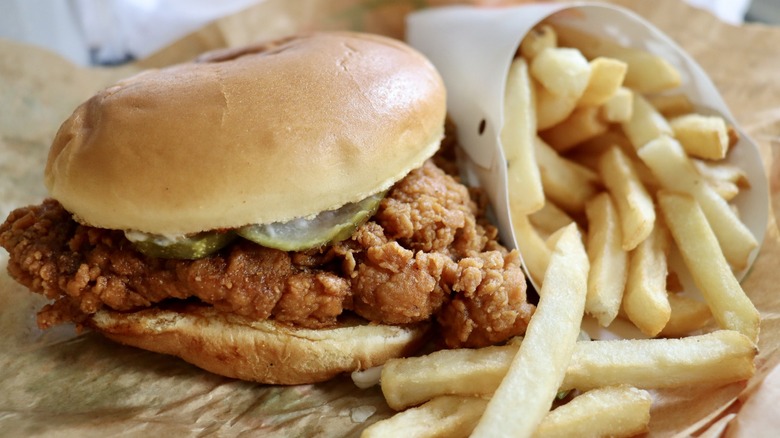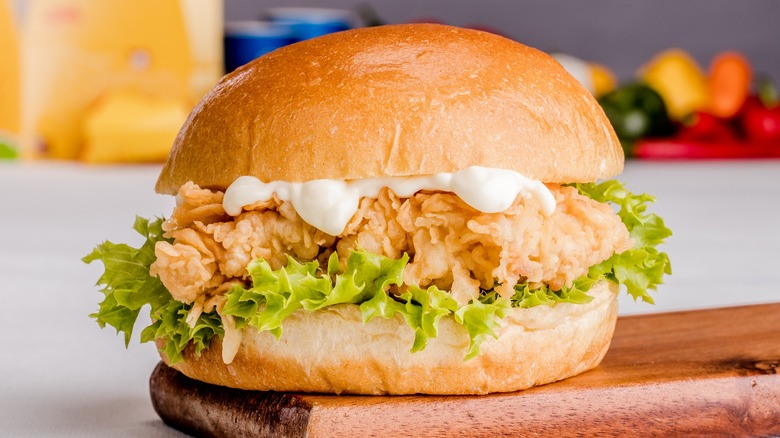The Reason Dark Meat Isn't Used For Restaurant Chicken Sandwiches
There's no denying that people love chicken, particularly as takeout and fried chicken sandwiches. This is even more apparent with statistics from the Food and Agriculture Organization of the United Nations (per Our World in Data) conveying that in 2020, chicken was the world's leading protein of choice, with 16.21 kilograms (a little over 35 pounds) of meat being consumed per individual annually.
However, white meat tends to be the preferred part of the bird, at least in the United States. And popular fast-food restaurants have been trying to meet that demand, especially with chicken sandwiches, partly thanks to the chicken sandwich wars. Nevertheless, people's preferences have played a role in dictating which cuts of poultry have been served in restaurants for a while now, and those choices have, in turn, been impacted by past public health concerns, mainly revolving around eating red meat.
This has led to market conditions where most consumers believe white meat is healthier than dark meat, which is debatable and has also impacted the sale and distribution of poultry worldwide. Most of America's dark meat has been exported overseas, primarily to China and Russia, in the past. Still, that has been changing for some time, so thighs and legs may appear more at food establishments and in sandwiches in the future, but some think it'll take some time.
Health concerns made chicken breast sandwiches fast food's focus
According to the National Chicken Council, the current chicken industry was established in the 1920s with broilers. Before this, meat production was typically seen as an afterthought behind the egg industry. However, this larger breed took over the market and became the country's main poultry supply in the '50s. This was because of the still ongoing popularity of white meat and the use of broilers by producers due to their lower cost, perceived value, and higher breast yield.
This compelled the industry to heavily promote these birds, as explained by food historian and author of "Putting Meat on the American Table" Roger Horowitz: "In the '50s and '60s, you see where these agricultural extension operations start pushing out recipes very aggressively about broilers" (per The Guardian).
Still, some rising demand for white meat stemmed from former health concerns, especially over red meat and heart disease, which gained greater traction in the '70s. Moreover, it seems shoppers never stopped listening to the warnings since white meat is often toted as the healthier cut because it contains less fat, so chicken breast sandwiches still reign supreme. But that's not strictly the case. While dark meat is higher in fat, it comprises beneficial monounsaturated fats, similar to white meat. Additionally, it's an excellent place to get some essential vitamins and minerals, like niacin and vitamin B6.
Dark meat may soon be seen on chicken sandwiches more often
There's been a growing trend within the chicken industry since the late '90s to adjust the desire for white meat to dark, but with little previous success since the best chicken sandwiches in America typically use breast meat. Still, some of it has to do with external factors. While the demand for white meat has controlled sales for decades, legs and thighs have generally been sent to foreign consumers. This is because, as the chairman and chief executive of Perdue Farms told the Los Angeles Times around that period, "If you go anywhere — Southeast Asia, Mexico, South America — dark meat is preferred and commands a higher price than white meat."
And those buyers have a point. Most chefs agree it tastes and works better in dishes because it is less inclined to dry out and gathers more of a meal's nuances during cooking.
Nevertheless, despite this business model having worked efficiently while the United States has continued its white meat love affair, those outside markets have dried up over the last decade. Additionally, the fluctuating price of chicken due to shortages has led some chains to offer thighs in chicken sandwiches. This is a good thing since it'll address the issues with outside demand and meet changing domestic tastes, which appear to be finally willing to accept thighs and legs. So, maybe the dark meat chicken sandwich's time is on the horizon.


